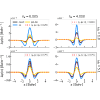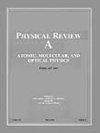Electron-photon exchange-correlation approximation for quantum-electrodynamical density-functional theory
IF 2.6
2区 物理与天体物理
Q2 OPTICS
引用次数: 0
Abstract
Quantum-electrodynamical density-functional theory (QEDFT) provides a promising avenue for exploring complex light-matter interactions in optical cavities for real materials. Similar to conventional density-functional theory, the Kohn-Sham formulation of QEDFT needs approximations for the generally unknown exchange-correlation functional. In addition to the usual electron-electron exchange-correlation potential, an approximation for the electron-photon exchange-correlation potential is needed. A recent electron-photon exchange functional [C. Schäfer , ], derived from the equation of motion of the nonrelativistic Pauli-Fierz Hamiltonian, shows robust performance in one-dimensional systems across weak- and strong-coupling regimes. Yet, its performance in reproducing electron densities in higher dimensions remains unexplored. Here we consider this QEDFT functional approximation from one- to three-dimensional finite systems and across weak to strong light-matter couplings. The electron-photon exchange approximation provides excellent results in the ultrastrong-coupling regime. However, to ensure accuracy also in the weak-coupling regime across higher dimensions, we introduce a computationally efficient renormalization factor for the electron-photon exchange functional, which accounts for part of the electron-photon correlation contribution. These findings extend the applicability of photon-exchange-based functionals to realistic cavity-matter systems, fostering the field of cavity QED (quantum-electrodynamics) materials engineering. Published by the American Physical Society 2024

量子电动力学密度函数理论的电子光子交换相关近似值
量子电动力学密度泛函理论(QEDFT)为探索真实材料光腔中复杂的光-物质相互作用提供了一条大有可为的途径。与传统的密度函数理论类似,QEDFT 的 Kohn-Sham 公式需要对一般未知的交换相关函数进行近似。除了通常的电子-电子交换相关势之外,还需要对电子-光子交换相关势进行近似。最近的一种电子-光子交换函数[C. Schäfer , ]是从非相对论的保利-菲尔兹哈密尔顿的运动方程中推导出来的,在一维系统中显示出跨越弱耦合和强耦合体系的强大性能。然而,它在再现高维度电子密度方面的性能仍有待探索。在此,我们考虑了从一维到三维有限系统、从弱到强光物质耦合的 QEDFT 函数近似。电子光子交换近似在超强耦合体系中提供了出色的结果。然而,为了确保在更高维度的弱耦合机制中也能获得准确的结果,我们为电子-光子交换函数引入了一个计算效率高的重正化因子,它包含了电子-光子相关贡献的一部分。这些发现扩展了基于光子交换的函数在现实空穴物质系统中的适用性,促进了空穴 QED(量子电动力学)材料工程领域的发展。 美国物理学会出版 2024
本文章由计算机程序翻译,如有差异,请以英文原文为准。
求助全文
约1分钟内获得全文
求助全文
来源期刊

Physical Review a
OPTICSPHYSICS, ATOMIC, MOLECULAR & CHEMICA-PHYSICS, ATOMIC, MOLECULAR & CHEMICAL
CiteScore
5.30
自引率
24.10%
发文量
2086
期刊介绍:
Physical Review A (PRA) publishes important developments in the rapidly evolving areas of atomic, molecular, and optical (AMO) physics, quantum information, and related fundamental concepts.
PRA covers atomic, molecular, and optical physics, foundations of quantum mechanics, and quantum information, including:
-Fundamental concepts
-Quantum information
-Atomic and molecular structure and dynamics; high-precision measurement
-Atomic and molecular collisions and interactions
-Atomic and molecular processes in external fields, including interactions with strong fields and short pulses
-Matter waves and collective properties of cold atoms and molecules
-Quantum optics, physics of lasers, nonlinear optics, and classical optics
文献相关原料
| 公司名称 | 产品信息 | 采购帮参考价格 |
|---|
 求助内容:
求助内容: 应助结果提醒方式:
应助结果提醒方式:


